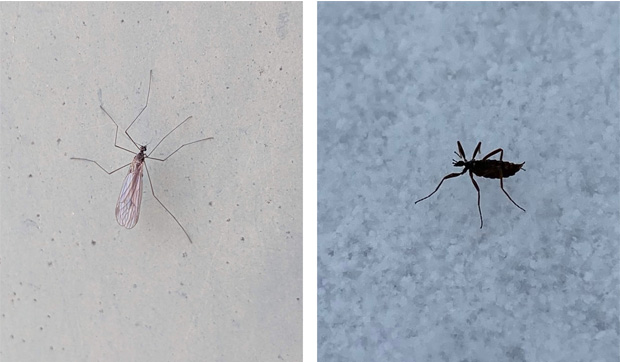Besides sharing the trait of being active in winter, these insects also share a common ancestor and are members of the insect infraorder Tipulomorpha. The winter crane fly, right, kept its wings while the snow fly did not.
Good Natured: Snow Flies & Winter Crane Flies
January 20, 2023
At first we couldn’t believe our eyes.
A small gray object-actually several small gray objects-fluttered through the air, looking for all the world like insects. But how could that be? It’s winter. Isn’t that the season when most bugs take a breather?
My friend Bonnie and I, out for a walk on a recent warm-ish, sunny-ish day, moved in for a closer look. We had to squint a bit to focus but, holy cow! The details were undeniable. Head, thorax, abdomen; two antennae, six legs… Sure enough, we were looking at honest-to-goodness insects! Flying! In winter!
Our brains switched modes from observing to categorizing, and mine clicked on a group of critters known as midges. Plentiful in spring, summer and fall, they look a lot like mosquitoes but belong to a family all their own-the Chironomidae, or non-biting midges. They tend to be seen in small clouds (which actually are mating swarms) with an uncanny knack for flying around our heads, and into mouths and noses.
There was only one problem. I was wrong.
While the insects Bonnie and I observed had one pair of wings, just as midges do (two wings are a hallmark of the Diptera, or true flies) the beautifully veined structures were a little larger than those of a typical midge. The legs were longer too. But at the time we were perfectly happy to accept the midge diagnosis and move along to other wonders on that gloriously warm day.
It wasn’t until a week later that I realized I’d made a booboo.
That day my friend Valerie texted me a photo of a small, dark, wingless insect, accompanied by the words “At Leroy (Oakes Forest Preserve in St. Charles). Do you know what this is?”
I had no clue, but was lucky enough to have my friend Google along with a few extra minutes. It didn’t take long to track down a likely suspect: a snow fly of the genus Chionea (a most excellent scientific name derived from chion, the Greek word for snow).
Now I’d heard of snow fleas before, but snow flies? That sounded more like a brief sentence than the name of an insect.
It turns out that snow flies are fairly common, but often overlooked by humans because of how we behave when the snow is, well, flying. Rather than the leisurely pace we adopt when conditions are mild, our winter gaits tend to be somewhat hurried and focused on a destination. We tend to miss the little details along the way.
And by little, I mean tiny. The average length of a snow fly is 7mm, which translates to just over 1/4 in. But that teensy body is packed with astounding adaptations that make life in, and under, the snow a breeze!
Snow flies are able to produce glycerol, a sugar alcohol that functions like antifreeze and allows them to go about their business at temperatures around 25F. In fact, when subjected to a source of heat, like a sunbeam or a warm finger, a snow fly will actually head the other way.
Their dark bodies are easiest to spot when they’re walking across white snow, but these insects typically spend quite a bit of time beneath the snow, hanging out in places like rodent burrows. A life down under, so to speak, means wings aren’t just useless, but actually a detriment. And so, these insects have none.
So how do we know they’re flies?
Looking at things like the mouth, eyes, leg segments and places we would call private, entomologists have determined that snow flies are part of the insect infraorder Tipulomorpha-the crane flies. (You probably know crane flies even if you don’t realize it. They’re the summertime fliers that, with a wingspan of up to 2 in., look like enormous mosquitos but do not bite.)
And here’s where our story comes full circle. Remember the insects Bonnie and I found, that I thought were some sort of midge? Well guess what? They’re a type of crane fly too!
In learning more about snow flies, it was impossible to ignore the repeated mentions of other cold-tolerant insects, and tops among them are small winged insects in the genus Trichocera, also known as winter crane flies.
Looking more closely at the photos I’d taken, I could see not only the delicate crane fly-esque venation of the wings, but two small structures underneath called halteres. These knobbed filaments, one on either side of the body, take the place of the hindwings and enable flies to keep their balance in the air. While lots of different kinds of flies have halteres, they’re easiest to see on crane flies.
Now, can you guess what small, dark, wingless insect also has halteres?
That’s right! Even though they don’t fly, snow flies have a wee little knob on each side of their body. Do the structures still serve a balancing function? I don’t know. But since snow flies have been clocked moving at 4 ft./min., I suppose there’s a chance.
Next time you’re out and about on a warm-ish winter’s day, don’t rule out the possibility of running into some insects. Look around for small gray objects fluttering through the air, or black specks crawling across the snow. I’ll bet you won’t believe your eyes!
Pam Otto is the outreach ambassador for the St. Charles Park District. She can be reached at potto@stcparks.org.

